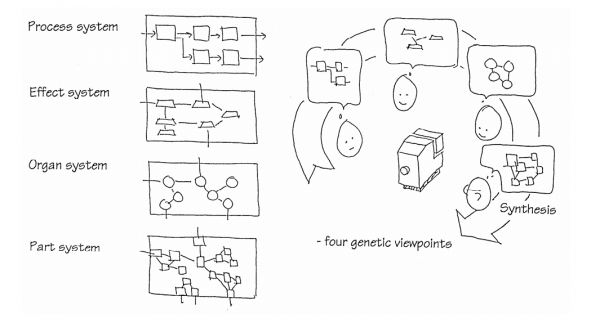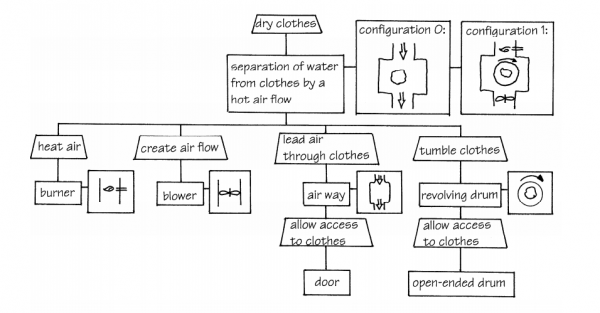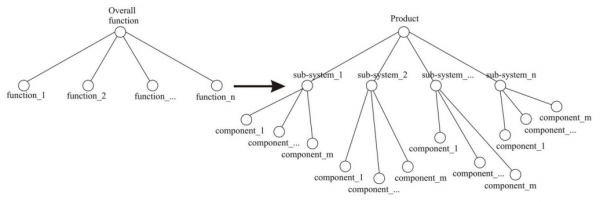Product structure modeling: Difference between revisions
No edit summary |
|||
| Line 23: | Line 23: | ||
=Product-Function-Component tree= | =Product-Function-Component tree= | ||
Product-Function-Component tree is rooted with product on the top of the tree, and then a merge of functions to next tree-level is made. Since in this stage we know nothing about product sub-systems or subassemblies, i.e. we know nothing about product’s component structure we assign functions to the second-tree level so they will substitute product’s subsystems. Assumption made here is that a product can be broken down into subassemblies corresponding to the functions of the technical system. According to this, Product-Function-Component tree is created by merging two dependant tree structures. <ref name="midzic" /> | Product-Function-Component tree is rooted with product on the top of the tree, and then a merge of functions to next tree-level is made. Since in this stage we know nothing about product sub-systems or subassemblies, i.e. we know nothing about product’s component structure we assign functions to the second-tree level so they will substitute product’s subsystems. Assumption made here is that a product can be broken down into subassemblies corresponding to the functions of the technical system. According to this, Product-Function-Component tree is created by merging two dependant tree structures. <ref name="midzic" /> | ||
[[File:Function-means-product-tree-midzic.png|center|600px]] | |||
=References= | =References= | ||
Revision as of 23:54, 4 May 2020
Introduction
Product structure [modeling] is a hierarchical decomposition of a product, typically known as the Bill of Materials (BOM).—Wikipedia, [1]
Domain Theory
Domain Theory is a systems approach for the analysis and synthesis of products. Its basic idea is to view a product as systems of activities, organs and parts and to define structure, elements, behaviour and function in these domain.
According to Domain Theory, a product is seen from four system point of views:[3]
- A process view, where the transformation of materials, energy, and information of the product related to its use or function is central. This viewpoint lead to description of a process structure.
- An effect view, where the desired functions or effects are in focus. These effects must be able to facilitate the necessary transformations. This viewpoint is related to an effect / function structure.
- An organ view, where the technical principles or means of the product are in focus. These principles or solutions are called organs (or function carriers) and by their functionality they create the desired effects. The result of design considerations is an organ structure.
- A part view (or assembly view), where the machine parts of the products are in focus. By determining material, form, tolerances and surface quality of each part and relations between the parts, the necessary conditions for the organs and their functionality are created.
Function-oriented decomposition
Each of the four structural views indicates possible ways of decomposing a product or product assortment. Functional decomposition seems to be the core of decomposition because it can be argued that functionality is the most important property of a product, i.e. if the product does not possesses right functions then other properties are uninteresting. [3]
Product-Function-Component tree
Product-Function-Component tree is rooted with product on the top of the tree, and then a merge of functions to next tree-level is made. Since in this stage we know nothing about product sub-systems or subassemblies, i.e. we know nothing about product’s component structure we assign functions to the second-tree level so they will substitute product’s subsystems. Assumption made here is that a product can be broken down into subassemblies corresponding to the functions of the technical system. According to this, Product-Function-Component tree is created by merging two dependant tree structures. [4]
References
- ↑ Wikipedia - Product structure modeling
- ↑ Andreasen, Mogens & Howard, Thomas & Bruun, Hans. (2014). Domain Theory, Its Models and Concepts. 10.1007/978-1-4471-6338-1_9.
- ↑ 3.0 3.1 Structuring as a basis for Product Modelling: Niels Henrik Mortensen, Claus Thorp Hansen
- ↑ Midžić, Ida et al. “CONTEXT-FREE GRAMMAR BASED RULES FOR COMPONENT-LEVEL PRODUCT STRUCTURE MODELLING.” (2010).


